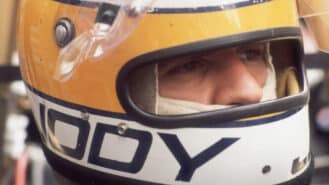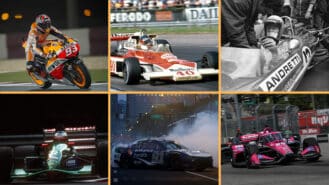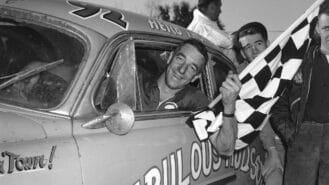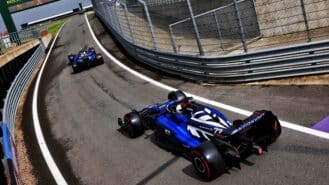I had a birthday last week and it must have been a significant one because into my lap thumped my very own copy of the greatest work of research yet published in the field of motor racing.

You may know Time and Two Seats by Janos Wimpffen, you may even have your own. For myself and for the 15 years since a review copy came to Motor Sport, which it was my privilege to be editing at the time, I’ve been trying to forget it. Or, more specifically, the fact that I didn’t get to keep it.
Enough time has probably passed for me to admit now how close I came to walking out of the Motor Sport editorial offices with that book tucked under my arm. At the time it cost ‘only’ £129.99 and I knew how valuable a tool it would be for my new life as a freelance hack; had I known its value would soon rise to four figures for a pristine example I’d have probably thought harder still.

There’s only one copy on Amazon… for £1199…
The package in which it came was, after all, addressed to me. But I couldn’t bring myself to do it and though it has been the one glaring omission from my small reference library this last decade and a half, I’m glad I left it in the office where it was needed most and intended by its author to reside.
Life has got considerably better of late thanks to Motor Sport’s new, vast and still burgeoning database which, combined with the extant online archive, now offers a far more space efficient, affordable and easily-browsed alternative to owning the entire run of back issues, but if you still like to view your reading material between two covers, for someone like me this book has no equal.
As it says on the cover, Time and Two Seats chronicles ‘five decades of long distance racing’ from the start of the World Sportscar Championship in 1953 to the end of the 1998 season, but to a level of detail I can barely comprehend, even sitting here with it in front of me.
It extends to two volumes, 23 chapters and 2255 pages. But if you really want a feel for the amount of effort it represents, the fact that listed in the acknowledgements are the names of, conservatively, 600 people who helped Wimpffen, provides at least a little insight into what we’re dealing with here.

Every important detail of every one of the 614 races it comprises is here, not just in statistical form but paragraphs of narrative for every race too. I learned just now, by opening the book at a random page, about the tragic death of Erwin Bauer after the end of the 1958 Nürburgring 1000km. Driving a Ferrari Testa Rossa he failed to realise the event was over, continued at race pace and crashed into a tree on what Wimpffen describes as ‘a wholly redundant lap’.

Every single point scored by every single driver and team in the World Sportscar, Grand Touring and Manufacturers’ Championships is here along with lengthy explanations of driver and rule changes, new car and track configurations before every season.
But for me as an enthusiast with an addiction to weapons-grade motor racing trivia, rather than just a hack looking for facts to back up a story, it is the final section called ‘Superlatives’ that I know I’ll be lost in for longest. Another random trawl reveals that the greatest winning margin of any race went to Danny Ongais, Hurley Haywood and Ted Field in the 1979 Daytona 24 Hours, who covered 188 more miles than the next fastest competitor.
And what would you expect to be the most successful driver pairing in this period? In fact it was Jacky Ickx and Jochen Mass, with an astonishing 19 wins, more than double that of Henri Pescarolo and Gérard Larrousse, who came second with nine. Then again, three of Derek Bell’s many partnerships appear in the top 13 listed, while not even Ickx or Mass managed more than two.

Who’d have thought the seventh most successful pairing in this period would be Bernd Schneider and Mark Webber? And asked to name the man with the greatest number of points, which way would you go? Mass? Ickx? Bell? Wrong, wrong and wrong again. It was Bob Wollek. There are even 12 full-length columns of text devoted simply to unmasking drivers who raced under false names. For years I have pondered the identity of ‘Pooky’. I ponder no more – Vincenzo Cazzago as you’re asking.
It would be so easy now to exhort you to go and get your own copy, and smugly so as thanks to one person’s extraordinary generosity, the wait for my own is now over. You might even suspect I write these words to talk up its value further, though as I’ll never sell it, whether it is worth tens, hundreds or thousands of pounds in the future is at last no longer of relevance or interest to me.
But the truth is this is a hideously expensive book, sufficiently so to keep it off my shelves these last 15 years, and while Wimpffen did many years ago make some noises about producing a second and up to date edition that would presumably be far more affordable, I have heard nothing of late.
But if you can raise the steam, or know of any other way to bring this book into your home save stealing it, I cannot see that you could regret it. Before Time and Two Seats appeared, I always considered Laurence Pomeroy’s The Grand Prix Car to be the greatest motor racing reference book ever published. Time and Two Seats eclipses that achievement and with ease.









